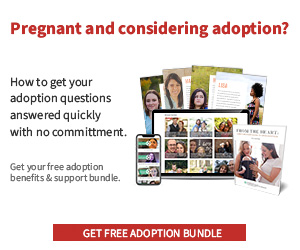-
Choosing Adoption
If you have found yourself unexpectedly pregnant, and are considering placing your child for adoption, you may be asking yourself how adoption works. How am I going to take care of myself and this child growing in my womb during this uncertain time? What is the next step in this process? How do I find the perfect parents for my unborn child? Most women in your shoes ask these very same questions, and hopefully, this outline will help answer some of your questions and give you the peace of mind you desire and desperately need during a time when nothing seems right.
I always feel more comfortable talking through my decisions with someone, especially if that someone has walked through a similar situation. It helps to analyze your current circumstances and what lies in the future, but the emotional support from other expectant parents or birth parents is invaluable. You can find all of this on the forums found here and here. Additionally, Birth Mothers Amplified is a new podcast where birth moms answer common questions and share their own adoption stories. These forums and podcast episodes will also help explain how adoption works and how it worked out for them.
If you are needing more clarity on whether adoption is the right choice for you, the following links may help you as well:
– Choosing Adoption For Your Baby Guide
-
Adoption Agency or Adoption Attorney
When researching exactly how adoption works in hopes to answer all of your questions, the first step in placing your child for adoption is finding the organization/individual, whether it is an adoption agency, Catholic charity, or an adoption attorney to facilitate the process from start to finish.
There are plenty of adoption agencies available in this country. No matter which state you are located in, there is an agency that can speak with you in regards to an adoption plan. Even if you are located in another state than the agency, many agencies work with birth mothers located in other states and still match you with adoptive parents. They even help you through placement. The Gladney Center for Adoption is an agency that works with expectant parents in every state and has been part of the adoption world for 130 years.
Agencies are incredible resources when choosing adoption. If you are still unsure about adoption, agencies have professionals readily available to counsel and inform you of your options.
Most information out there for expectant parents is in regards to adoption agencies, but the alternate choice is an adoption attorney. Adoption attorneys work with adoptive parents and usually have a large network of local couples ready to welcome a child into their hearts and home. One major component of how adoption works is the legal legwork before and after the birth of the child. Some forget how important the legal processes are and that they vary from state to state. An adoption attorney in your state will be well-versed in the local state adoption law. An adoption attorney is also able to handle the possible financial assistance between the adoptive parents and you as an expectant parent (housing, food, medical, transportation), making sure it meets all state requirements. What type of financial assistance and how much varies per state, so you will need to check with your adoption attorney to see what financial assistance may be available to you.
You can choose whether an agency or an attorney would be a good fit for you. Either way, they can walk you through each step of the process. Many birth mothers prefer an adoption agency because they feel the agency is their voice and represents them while also providing support along the way, whereas an adoption attorney is hired by the adoptive parents.
Whether you sign up with an agency or are connected with an adoption attorney, neither choice is good or bad. It is ultimately what is the best fit for you at the time.
-
Adoptive Parents
The next step in how adoption works would be to begin the process of choosing adoptive parents for your child. Both an agency and an adoption attorney should have parent profiles for you to view and decide which parents will be the perfect choice for your child. The profile books you view will most likely cover a large range of topics from the couples’ life, interests, religion, pictures of their home, long-term goals/plans, community, and any other tidbits they want to share with you.
Browsing page after page of someone else’s life and envisioning your child in it can be hard. Making an initial connection with the couple is key in finding who you want to parent your child. Whether it is religious beliefs or the hobby he or she enjoys on the side, something will stand out to you when the couple is the right fit. Many birth mothers describe the match as intuition or a gut feeling they had when browsing the profile book. When you know, you know.
-
Open or Closed?
Aside from choosing your child’s future parents, deciding whether the adoption will be open or closed is the second most important part of how adoption works. This decision will determine your participation with your child after he or she is placed. Usually, the birth mother and adoptive parents discuss the level of involvement after placement from the beginning or share with their representatives what they’re comfortable with who then relay the message to the appropriate parties. If you choose a closed adoption, the adoptive parents have minimal information about the birth mother, birth father, and extended family. No specific details are shared throughout the process other than information pertinent to the baby and the overall pregnancy. Closed adoptions were very common years ago, but today they aren’t as common.
Open adoptions can be semi-open or fully open. If you choose semi-open, some details are disclosed, but in-person contact is not common. Communication is usually through third parties and not directly with the adoptive parents. Some health information may be shared, and picture updates can be exchanged initially or until a certain date.
Fully open adoptions typically allow the birth parents and adoptive parents to communicate, visit, interact, and share information as much or as little as they want. Full names are usually disclosed and whatever level of openness is established by the parents, whether it visits once a year, twice a year, picture updates only, email updates periodically, etc., is determined in a fully open manner.
As an adoptive mother myself, the adoption of our daughter is fully open. We know the names of both birth parents, and there is communication with our daughter’s birth mother. There was a plan in place before our daughter was born for pictures, emails, social media interaction, and visits in the future. With anything in life, there is an ebb and flow to this openness, but as adoptive parents, the desires of our daughter’s birth mother are our utmost concern. What she is comfortable with at the time is always important, and ultimately, as our daughter grows, our daughter’s well-being with the circumstances of the adoption will become the most important. In our situation, we plan to be forthcoming about the adoption with our daughter in hopes that her questions and emotions will be addressed early and fully throughout her life. We always want her to know where she came from and leave the connection open so she can talk to her birth parents as needed.
At the end, open or closed, this choice is entirely up to you as a birth mother.
-
Working on the Relationship
Once you have chosen the adoptive parents, working on your relationship with them for the future event of the child’s birth is important. Whether you are emailing, texting, talking on the phone, FaceTiming, or visiting in person, it is all a building block to the big day. Getting to know the people on a more personal basis that will be parenting your biological child may put your heart at ease as you think about the big decision you are making for your child.
In some cases, this relationship is merely a few calls and text messages along the way. For us, we had the wonderful experience of every doctor’s visit, sonogram, and even eating out together with our daughter’s birth mother. We wanted her to know we were invested in the journey, and we loved her for choosing us and choosing life for the sweet baby girl she was carrying in her womb. This was a magical time for us because she included us in every detail.
As with each step of how adoption works, the pace and amount of contact are always up to the birth mother. This Guide to Building Relationships Between Expectant and Hopeful Adoptive Parents may help in this process.
-
Birth Plan
Prenatal visits are happening, sonograms are looking good, and the big day is nearing. What is next? Getting your birth plan in place is essential for a smooth transition. Usually, the counselor/social worker that meets with you beforehand will go over the birth plan with you. Here are some things you will need to consider:
– Who do you want in your labor/delivery room?
– Who will cut the umbilical cord?
– Will you have the first skin-to-skin contact with your child or will you allow the adoptive mother the experience?
– Will you nurse?
– Do you want alone time in the hospital with your child?
– Do you want the adoptive parents to have their own hospital room with your child?
– Will the birth father be present?
Pregnant and considering adoption?
Get your free adoption benefits and support bundle

– If you do give the adoptive parents full care of your child in the hospital, will you elect to leave before your child is discharged?
All of these things are big decisions and should be made with careful consideration of not only yourself but also your child. As an adoptive mother, I can attest to the importance of the initial bonding with a baby right after birth. Being present for our daughter’s birth and witnessing her take her first breath was a gift our daughter’s birth mother gave to us. We are incredibly grateful that she allowed us to experience it all with our daughter. I can share our daughter’s birth story with her and reminisce all the details because I was there and experienced it.
At the same time, I have a lot of empathy for a birth mother during this time and how important final closure is in the process of healing. Taking the time to enjoy the simple and powerful moments right after birth and those first couple of days with your child before placement is something no one else will go through except you. Do what is right for you. If you need privacy and want those moments with only you and your baby, take that time with your child. If you feel comfortable including the adoptive parents, go for it. As with everything in adoption, neither decision is wrong. It is all up to you.
-
Counseling/Emotional Preparation
Each state has different counseling requirements, and those will be conveyed to you either by your agency or adoption attorney. You will most likely need to meet these requirements either by the birth of your child or after birth, depending on your state.
Placing your child for adoption is a very heavy and emotional decision. It is paramount to take care of your mental and emotional health during this time. Take the counseling seriously, and if there is a support group for birth mothers in your area, utilize that resource. Again, there is invaluable support from others that have walked the same road as you and truly understand what it is like to place a child. It’s hard. It’s a massive decision made out of selfless, unconditional love from a mother’s heart. Don’t underestimate the power of counseling and group support. Check with your agency or adoption attorney for support groups. Emotionally prepare yourself for this can lift you and create a firm foundation for the future.
-
Birth
The big day is here, and your birth plan is in place. Although you may have a place and all the details nailed down, come the big day, it may all go out the window, and you might change your mind when you give birth. And you know what? That’s okay. That’s how adoption works. It’s fluid, and things can change from one minute to the next. Adoptive parents know this. Agencies know this. Adoption attorneys know this. You, as the birth mother, are steering the ship until placement. Always remember that. The decision is yours.
-
Placement
Depending on the state, birth parents may place their child in as little as 12 hours after birth or as much as five days. It all depends on the state you are in and the laws in place. All of this will be known before birth so that you are prepared for whatever window you may have to finalize your decision. If you are on the fence and need additional counseling, speak up and make sure the decision you are about to make is solid and for the right reasons.
Once your child is placed, and the window of revocation is gone, that is the final word. That is not to say you won’t be in the child’s life, but once your parental rights are terminated, you cannot go back on your decision.
-
Life Ever After
After placement, giving yourself time to heal emotionally and physically and to reflect on the major life decision would be wise. When you place a child for adoption, it is a loss, and the grieving process will begin immediately. Denying yourself the natural emotional roller coaster and stages of grief will only prolong the healing journey. Remind yourself of the reasons you chose the path of adoption for your child. Hold on to that. You probably wanted to give your child the life you could not give her or him at the time, and that is okay. You made an incredibly loving and courageous decision. Still, you will need to prepare yourself for some hard emotional days initially and throughout the first year or years after as well.
Depending on the openness of the adoption, you may be receiving pictures and even have visits scheduled not long after birth. It may help you to have something to look forward to, or it may still be too painful. Protect your heart and surround yourself with positive thoughts and people. Be kind to yourself. Grief will still be very real for you. Wherever you are or whatever headspace you are in, give yourself the grace to heal and move forward with your life. Work on meeting the goals you have set for yourself. Finish high school, finish college or graduate school, or get back on your feet financially. If you believe in a higher power, God’s purpose for your life is to find your value in Him, and just as He adopted each of us into His family, your child is being loved by his or her adoptive parents.
Hopefully, this outline has provided a step-by-step guide on how adoption works and what to expect if this is the route you choose for your child.
Remember, adoption is love.
Are you considering placing a child for adoption? Not sure what to do next? First, know that you are not alone. Visit Adoption.org or call 1-800-ADOPT-98 to speak to one of our Options Counselors to get compassionate, nonjudgmental support. We are here to assist you in any way we can.


